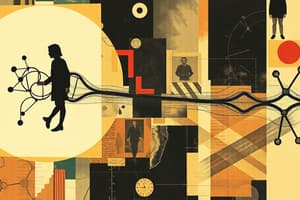Podcast
Questions and Answers
What is the primary characteristic of intra-cellular receptors?
What is the primary characteristic of intra-cellular receptors?
- They bind to lipophilic hormones. (correct)
- They are found within the cell membrane.
- They are attached by hydrophilic hormones.
- They only exist in the cytoplasm.
Which statement correctly describes the mechanism of action of Group 1 hormones?
Which statement correctly describes the mechanism of action of Group 1 hormones?
- They bind to extra-cellular receptors.
- They are influenced by hydrophilic signals.
- They induce the transcription of target genes by binding to DNA. (correct)
- They activate second messengers in the cytoplasm.
What type of second messenger is used by Group 2 hormones that include glucagon and catecholamines?
What type of second messenger is used by Group 2 hormones that include glucagon and catecholamines?
- Intrinsic protein kinase
- Calcium ions
- cGMP
- cAMP (correct)
Which hormone is associated with the guanylate cyclase c-GMP system?
Which hormone is associated with the guanylate cyclase c-GMP system?
What occurs when Group 2 hormones attach to their receptors on the cell surface?
What occurs when Group 2 hormones attach to their receptors on the cell surface?
What is the primary function of signal transduction?
What is the primary function of signal transduction?
Which type of signaling involves cells releasing signaling molecules that act on nearby target cells?
Which type of signaling involves cells releasing signaling molecules that act on nearby target cells?
Which of the following characteristics is true for lipophilic hormones?
Which of the following characteristics is true for lipophilic hormones?
What defines autocrine signaling?
What defines autocrine signaling?
What is the role of cellular receptors in signal transduction pathways?
What is the role of cellular receptors in signal transduction pathways?
Flashcards
Signal Transduction
Signal Transduction
Converting external signals into cellular responses.
Endocrine Signaling
Endocrine Signaling
Hormones from far away cells affect target cells.
Hydrophilic Hormones
Hydrophilic Hormones
Water-soluble hormones that bind to extracellular receptors.
Cellular Receptors
Cellular Receptors
Signup and view all the flashcards
Paracrine Signaling
Paracrine Signaling
Signup and view all the flashcards
Intracellular Receptors
Intracellular Receptors
Signup and view all the flashcards
Cell Surface Receptors
Cell Surface Receptors
Signup and view all the flashcards
Hormone Response Element (HRE)
Hormone Response Element (HRE)
Signup and view all the flashcards
Second Messenger
Second Messenger
Signup and view all the flashcards
cAMP
cAMP
Signup and view all the flashcards
Study Notes
Signal Transduction Pathways
- Signal transduction is the process of converting extracellular signals into cellular responses.
- This occurs through cellular receptors.
- Signaling types include endocrine, paracrine, and autocrine.
Types of Signaling
- Endocrine signaling: Signaling molecules (hormones) are released from distant cells to act on target cells.
- Paracrine signaling: Signaling molecules (neurotransmitters) are released from organs/cells close to target cells.
- Autocrine signaling: Signaling molecules (growth factors) are released from the same target cells.
Steps of Hormonal Signaling
- Hormone biosynthesis in a specific tissue.
- Hormone storage and secretion.
- Hormone transport to target cells.
- Recognition by receptors (intracellular or membrane-bound).
- Signal transduction (relay and amplification).
- Potential feedback to the hormone-producing cell.
Types of Hormones
- Lipophilic hormones (Group I): Dissolve in fat, not water. Mostly organic, nonpolar compounds (e.g., steroids, sex hormones, thyroid hormones). Work through intracellular receptors, require transport proteins, long half-life.
- Hydrophilic hormones (Group II): Dissolve in water, not fat. Contain polar groups (e.g., proteins, carbohydrates). Work through extracellular receptors, do not need transport proteins, short half-life.
Types of Cellular Receptors
- Intracellular receptors: Located inside the cell (cytoplasm or nucleus). Attached to lipophilic hormones.
- Cell surface receptors (extracellular receptors): Located on the cell membrane. Attached to hydrophilic hormones.
Mechanism of Action of Group 1 Hormones (Lipophilic)
- Hormones diffuse through the cell membrane.
- Bind to intracellular receptors (in cytosol or nucleus).
- Hormone-receptor complex is activated.
- Complex binds to DNA at specific Hormone Response Elements (HERs).
- Regulates gene expression (either by enhancing or silencing the transcription).
Mechanism of Action of Group 2 Hormones (Hydrophilic)
- Hormones bind to cell surface receptors.
- Second messengers (e.g., cAMP, cGMP, Ca, phospholipids) are activated within the cell.
- Second messenger cascade affects cellular function.
- Examples include glucagon, catecholamines, TSH, FSH, LH, ANF, vasopressin, TRH, GnRH, insulin, and growth factors.
Studying That Suits You
Use AI to generate personalized quizzes and flashcards to suit your learning preferences.




